Hydrocarbon Generation Potential and Molecular Composition of Eocene Guchengzi Formation Coals and Carbonaceous Mudstones from the Fushun Basin, NE China
Abstract
:1. Introduction
2. Geological Setting
3. Samples and Methods
3.1. Samples
3.2. Methods
4. Results
4.1. Bulk Composition
4.2. Geochemistry of Saturated Hydrocarbons
4.3. Aromatic Hydrocarbons
5. Discussions
6. Conclusions
Author Contributions
Funding
Data Availability Statement
Acknowledgments
Conflicts of Interest
Appendix A
| Height (cm) | S1 (mg/g) | S2 (mg/g) | S3 (mg/g) | S3CO (mg/g) | S3′CO (mg/g) | Tmax (°C) | PC (%) | RC (%) | TOC (%) | OI | HI | OICO |
|---|---|---|---|---|---|---|---|---|---|---|---|---|
| 2.5 | 0.34 | 14.20 | 0.24 | 0.23 | 0.45 | 434 | 1.23 | 2.77 | 4.00 | 6 | 355 | 6 |
| 12 | 1.38 | 194.10 | 5.57 | 3.62 | 8.97 | 417 | 16.72 | 47.91 | 64.63 | 9 | 300 | 6 |
| 23 | 1.31 | 162.08 | 5.64 | 5.55 | 8.17 | 421 | 14.13 | 47.41 | 61.54 | 9 | 263 | 9 |
| 33 | 0.78 | 179.27 | 4.61 | 3.29 | 7.41 | 421 | 15.37 | 45.90 | 61.27 | 8 | 293 | 5 |
| 38 | 1.27 | 165.91 | 5.84 | 5.48 | 7.52 | 421 | 14.43 | 54.06 | 68.49 | 9 | 242 | 8 |
| 43 | 1.04 | 160.91 | 5.82 | 3.67 | 9.11 | 420 | 13.95 | 52.92 | 66.88 | 9 | 241 | 5 |
| 53 | 1.22 | 165.33 | 5.99 | 5.72 | 8.38 | 420 | 14.41 | 56.02 | 70.43 | 9 | 235 | 8 |
| 63 | 1.15 | 126.69 | 6.17 | 5.91 | 9.00 | 425 | 11.23 | 53.14 | 64.36 | 10 | 197 | 9 |
| 68 | 1.25 | 158.84 | 5.79 | 5.49 | 8.07 | 417 | 13.85 | 53.43 | 67.28 | 9 | 236 | 8 |
| 73 | 1.87 | 239.07 | 3.81 | 3.16 | 5.04 | 418 | 20.35 | 35.59 | 55.94 | 7 | 427 | 6 |
| 78 | 1.07 | 174.30 | 5.85 | 5.62 | 8.20 | 421 | 15.13 | 54.59 | 69.72 | 8 | 250 | 8 |
| 98 | 1.03 | 211.04 | 5.39 | 3.58 | 8.42 | 418 | 18.08 | 49.38 | 67.47 | 8 | 313 | 5 |
| 103 | 0.76 | 183.51 | 5.74 | 3.68 | 9.30 | 416 | 15.81 | 52.42 | 68.23 | 8 | 269 | 5 |
| 108 | 1.26 | 154.38 | 6.69 | 4.06 | 8.68 | 417 | 13.46 | 52.76 | 66.22 | 10 | 233 | 6 |
| 113 | 0.82 | 95.37 | 1.51 | 1.40 | 1.79 | 426 | 8.12 | 12.60 | 20.72 | 7 | 460 | 7 |
| 118 | 0.24 | 17.93 | 0.63 | 0.50 | 1.02 | 429 | 1.57 | 5.50 | 7.06 | 9 | 254 | 7 |
| 123 | 0.13 | 28.47 | 2.18 | 1.90 | 2.14 | 427 | 2.56 | 13.29 | 15.85 | 14 | 180 | 12 |
| 128 | 0.29 | 34.08 | 2.37 | 1.49 | 2.59 | 428 | 3.04 | 15.38 | 18.42 | 13 | 185 | 8 |
| 138 | 0.41 | 30.81 | 1.09 | 0.79 | 1.73 | 427 | 2.69 | 10.12 | 12.81 | 9 | 240 | 6 |
| 148 | 0.96 | 181.40 | 6.06 | 3.62 | 9.06 | 417 | 15.65 | 53.29 | 68.94 | 9 | 263 | 5 |
| 188 | 1.65 | 191.18 | 5.71 | 5.46 | 8.04 | 419 | 16.57 | 52.25 | 68.81 | 8 | 278 | 8 |
| 208 | 0.86 | 170.96 | 5.79 | 5.43 | 8.23 | 417 | 14.83 | 53.88 | 68.71 | 8 | 249 | 8 |
| 228 | 0.90 | 68.90 | 2.72 | 1.98 | 3.82 | 415 | 6.03 | 24.64 | 30.68 | 9 | 225 | 6 |
| 243 | 0.07 | 3.83 | 0.39 | 0.33 | 0.42 | 436 | 0.36 | 2.03 | 2.39 | 17 | 160 | 14 |
| 273 | 1.11 | 140.17 | 5.64 | 5.35 | 7.34 | 419 | 12.27 | 53.56 | 65.83 | 9 | 213 | 8 |
| 293 | 1.39 | 172.20 | 5.81 | 5.41 | 7.91 | 417 | 14.97 | 53.97 | 68.94 | 8 | 250 | 8 |
| 362 | 0.82 | 76.11 | 2.62 | 2.64 | 3.21 | 424 | 6.64 | 24.15 | 30.79 | 9 | 247 | 9 |
| 368 | 1.12 | 111.04 | 4.64 | 4.34 | 5.81 | 421 | 9.75 | 42.68 | 52.43 | 9 | 212 | 8 |
| 403 | 0.35 | 78.52 | 1.94 | 1.51 | 2.58 | 422 | 6.72 | 18.17 | 24.89 | 8 | 315 | 6 |
| 408 | 0.84 | 115.97 | 4.37 | 2.95 | 6.56 | 423 | 10.08 | 38.61 | 48.69 | 9 | 238 | 6 |
| 413 | 0.40 | 107.12 | 5.91 | 5.06 | 6.58 | 423 | 9.44 | 49.67 | 59.11 | 10 | 181 | 9 |
| 418 | 1.29 | 122.47 | 3.81 | 2.48 | 5.86 | 426 | 10.61 | 32.41 | 43.01 | 9 | 285 | 6 |
| 428 | 1.11 | 150.52 | 5.73 | 5.23 | 8.01 | 418 | 13.14 | 53.62 | 66.76 | 9 | 225 | 8 |
| 458 | 0.95 | 201.04 | 5.61 | 3.39 | 8.81 | 417 | 17.25 | 51.19 | 68.45 | 8 | 294 | 5 |
| 463 | 0.88 | 126.01 | 6.71 | 5.85 | 9.05 | 423 | 11.16 | 55.90 | 67.06 | 10 | 188 | 9 |
| 468 | 1.10 | 172.30 | 5.87 | 3.15 | 10.20 | 417 | 14.91 | 53.83 | 68.73 | 9 | 251 | 5 |
| 473 | 0.75 | 123.20 | 6.98 | 5.92 | 8.64 | 420 | 10.92 | 49.11 | 60.02 | 12 | 205 | 10 |
| 478 | 1.71 | 148.57 | 5.82 | 5.38 | 8.06 | 420 | 13.04 | 53.88 | 66.92 | 9 | 222 | 8 |
| 483 | 1.17 | 180.45 | 5.93 | 3.25 | 9.96 | 414 | 15.59 | 53.40 | 68.98 | 9 | 262 | 5 |
| 493 | 0.06 | 10.50 | 0.59 | 0.63 | 0.80 | 431 | 0.94 | 5.27 | 6.21 | 9 | 169 | 10 |
| 513 | 0.76 | 165.17 | 5.16 | 2.97 | 8.73 | 415 | 14.23 | 50.02 | 64.24 | 8 | 257 | 5 |
| 528 | 1.65 | 151.77 | 6.16 | 5.55 | 8.34 | 417 | 13.32 | 55.10 | 68.41 | 9 | 222 | 8 |
| 533 | 1.20 | 163.38 | 5.28 | 4.97 | 7.62 | 415 | 14.18 | 52.90 | 67.08 | 8 | 244 | 7 |
| 563 | 0.52 | 36.77 | 2.04 | 7.13 | 1.89 | 426 | 3.50 | 15.98 | 19.47 | 10 | 189 | 37 |
| 593 | 0.44 | 142.07 | 6.36 | 5.39 | 7.81 | 417 | 12.40 | 56.59 | 68.99 | 9 | 206 | 8 |
| 608 | 0.73 | 161.01 | 6.04 | 5.37 | 8.09 | 419 | 13.99 | 53.90 | 67.89 | 9 | 237 | 8 |
| 613 | 0.72 | 165.38 | 5.76 | 3.23 | 9.57 | 417 | 14.29 | 52.89 | 67.17 | 9 | 246 | 5 |
| 648 | 1.05 | 182.81 | 5.97 | 5.46 | 7.43 | 417 | 15.82 | 52.56 | 68.37 | 9 | 267 | 8 |
| 673 | 1.25 | 159.97 | 6.19 | 5.45 | 8.06 | 420 | 13.96 | 54.29 | 68.25 | 9 | 234 | 8 |
| 708 | 1.44 | 207.27 | 5.95 | 3.50 | 9.38 | 415 | 17.84 | 52.63 | 70.47 | 8 | 294 | 5 |
| 718 | 0.57 | 152.27 | 6.21 | 5.34 | 8.37 | 417 | 13.26 | 56.64 | 69.90 | 9 | 218 | 8 |
| 753 | 0.99 | 159.39 | 6.16 | 5.38 | 8.13 | 418 | 13.88 | 55.33 | 69.21 | 9 | 230 | 8 |
| 758 | 1.10 | 167.78 | 6.39 | 5.27 | 8.03 | 415 | 14.59 | 54.60 | 69.18 | 9 | 243 | 8 |
| 788 | 1.51 | 198.40 | 5.79 | 5.33 | 7.30 | 417 | 17.14 | 51.85 | 68.99 | 8 | 288 | 8 |
| 808 | 0.60 | 85.94 | 0.97 | 1.10 | 1.42 | 433 | 7.29 | 11.55 | 18.84 | 5 | 456 | 6 |
| 813 | 2.05 | 169.67 | 5.16 | 4.63 | 6.21 | 424 | 14.73 | 50.09 | 64.81 | 8 | 262 | 7 |
| 818 | 1.79 | 88.23 | 1.94 | 1.43 | 2.91 | 424 | 7.65 | 19.89 | 27.54 | 7 | 320 | 5 |
| 823 | 1.40 | 87.10 | 1.97 | 1.58 | 2.89 | 426 | 7.53 | 19.92 | 27.45 | 7 | 317 | 6 |
| 833 | 0.79 | 130.42 | 6.26 | 5.12 | 6.76 | 420 | 11.43 | 52.03 | 63.46 | 10 | 206 | 8 |
| 838 | 1.04 | 155.46 | 6.44 | 3.51 | 9.14 | 421 | 13.51 | 53.52 | 67.03 | 10 | 232 | 5 |
| 843 | 1.81 | 207.36 | 5.75 | 3.45 | 8.55 | 417 | 17.85 | 50.75 | 68.60 | 8 | 302 | 5 |
| 853 | 1.61 | 193.06 | 5.77 | 3.28 | 9.11 | 420 | 16.65 | 51.97 | 68.62 | 8 | 281 | 5 |
| 868 | 1.53 | 221.58 | 3.70 | 2.80 | 5.47 | 420 | 18.86 | 38.89 | 57.74 | 6 | 384 | 5 |
| 953 | 1.97 | 205.17 | 5.20 | 5.04 | 6.77 | 419 | 17.70 | 48.45 | 66.14 | 8 | 310 | 8 |
| 958 | 1.23 | 184.36 | 5.73 | 5.78 | 7.03 | 419 | 15.96 | 49.95 | 65.91 | 9 | 280 | 9 |
| 963 | 1.00 | 183.22 | 5.95 | 5.18 | 7.42 | 419 | 15.83 | 52.47 | 68.30 | 9 | 268 | 8 |
| 973 | 1.55 | 190.98 | 5.86 | 3.16 | 8.91 | 418 | 16.47 | 52.17 | 68.64 | 9 | 278 | 5 |
| 978 | 1.69 | 200.04 | 5.96 | 3.38 | 9.37 | 419 | 17.25 | 52.57 | 69.82 | 9 | 287 | 5 |
| 1008 | 2.12 | 235.34 | 5.91 | 3.50 | 8.14 | 411 | 20.19 | 51.04 | 71.24 | 8 | 330 | 5 |
| 1013 | 2.87 | 267.94 | 5.54 | 3.69 | 7.15 | 414 | 22.94 | 47.37 | 70.31 | 8 | 381 | 5 |
| 1018 | 1.11 | 162.97 | 6.57 | 5.34 | 7.71 | 415 | 14.19 | 54.56 | 68.75 | 10 | 237 | 8 |
| 1023 | 1.62 | 169.26 | 5.94 | 4.88 | 6.95 | 421 | 14.70 | 52.15 | 66.85 | 9 | 253 | 7 |
| 1038 | 2.20 | 241.65 | 5.76 | 3.51 | 8.05 | 415 | 20.72 | 49.54 | 70.26 | 8 | 344 | 5 |
| 1053 | 2.93 | 202.07 | 5.35 | 3.24 | 7.89 | 426 | 17.47 | 49.40 | 66.87 | 8 | 302 | 5 |
| 1078 | 0.40 | 31.37 | 0.83 | 0.66 | 1.15 | 429 | 2.71 | 7.65 | 10.36 | 8 | 303 | 6 |
| 1083 | 0.52 | 43.74 | 2.06 | 1.35 | 2.42 | 429 | 3.84 | 15.34 | 19.18 | 11 | 228 | 7 |
| 1088 | 0.76 | 48.35 | 2.32 | 1.47 | 2.91 | 421 | 4.27 | 19.41 | 23.67 | 10 | 204 | 6 |
| 1093 | 0.20 | 26.16 | 1.42 | 1.32 | 1.62 | 423 | 2.32 | 11.46 | 13.78 | 10 | 190 | 10 |
| 1098 | 0.19 | 11.71 | 1.49 | 8.78 | 0.95 | 424 | 1.42 | 7.02 | 8.44 | 18 | 139 | 104 |
| 1118 | 0.22 | 16.66 | 0.85 | 0.81 | 0.86 | 425 | 1.48 | 5.83 | 7.31 | 12 | 228 | 11 |
| 1143 | 0.54 | 178.97 | 5.98 | 3.46 | 8.32 | 419 | 15.39 | 51.94 | 67.33 | 9 | 266 | 5 |
| 1153 | 1.39 | 168.07 | 5.71 | 5.13 | 7.50 | 421 | 14.60 | 51.77 | 66.38 | 9 | 253 | 8 |
| 1163 | 1.09 | 186.73 | 5.77 | 3.27 | 8.99 | 416 | 16.08 | 51.93 | 68.01 | 8 | 275 | 5 |
| 1177.5 | 1.30 | 202.08 | 6.15 | 3.48 | 8.85 | 415 | 17.39 | 51.60 | 68.99 | 9 | 293 | 5 |
| 1188 | 0.22 | 98.09 | 3.11 | 2.02 | 6.04 | 417 | 8.46 | 34.61 | 43.07 | 7 | 228 | 5 |
| 1203 | 0.42 | 134.77 | 6.38 | 5.57 | 8.12 | 421 | 11.81 | 52.04 | 63.84 | 10 | 211 | 9 |
| 1213 | 0.80 | 178.74 | 6.43 | 3.28 | 9.51 | 416 | 15.42 | 53.90 | 69.32 | 9 | 258 | 5 |
| 1223 | 2.61 | 287.54 | 4.78 | 3.44 | 5.72 | 422 | 24.48 | 41.70 | 66.18 | 7 | 434 | 5 |
| 1228 | 0.75 | 165.11 | 6.52 | 5.41 | 7.59 | 419 | 14.34 | 52.84 | 67.18 | 10 | 246 | 8 |
| 1238 | 0.56 | 155.69 | 6.74 | 5.47 | 7.69 | 421 | 13.55 | 54.40 | 67.96 | 10 | 229 | 8 |
| 1243 | 0.94 | 166.59 | 6.64 | 5.40 | 7.74 | 422 | 14.48 | 53.05 | 67.53 | 10 | 247 | 8 |
| 1248 | 0.82 | 189.27 | 6.35 | 5.45 | 7.59 | 418 | 16.35 | 51.67 | 68.01 | 9 | 278 | 8 |
| 1253 | 0.65 | 266.19 | 5.46 | 4.53 | 6.52 | 417 | 22.63 | 47.35 | 69.98 | 8 | 380 | 6 |
| 1258 | 0.91 | 150.32 | 5.52 | 6.71 | 6.39 | 421 | 13.13 | 45.49 | 58.62 | 9 | 256 | 11 |
| 1263 | 0.91 | 188.05 | 5.93 | 5.72 | 6.80 | 416 | 16.24 | 48.78 | 65.02 | 9 | 289 | 9 |
| 1273 | 0.84 | 171.36 | 6.40 | 3.45 | 9.17 | 418 | 14.81 | 52.38 | 67.19 | 10 | 255 | 5 |
| 1278 | 0.62 | 167.99 | 6.62 | 3.30 | 9.54 | 419 | 14.52 | 51.39 | 65.91 | 10 | 255 | 5 |
| 1283 | 1.14 | 239.14 | 5.68 | 3.39 | 7.99 | 418 | 20.42 | 49.93 | 70.34 | 8 | 340 | 5 |
| 1288 | 1.12 | 255.78 | 5.46 | 3.48 | 7.24 | 419 | 21.78 | 48.08 | 69.86 | 8 | 366 | 5 |
| 1293 | 0.92 | 161.18 | 6.49 | 5.21 | 7.59 | 419 | 14.02 | 53.86 | 67.87 | 10 | 237 | 8 |
| 1298 | 1.02 | 185.79 | 6.15 | 3.20 | 9.14 | 417 | 16.01 | 53.41 | 69.42 | 9 | 268 | 5 |
| 1303 | 1.93 | 238.59 | 5.31 | 3.25 | 7.10 | 418 | 20.40 | 46.90 | 67.30 | 8 | 355 | 5 |
| 1308 | 2.04 | 185.42 | 6.51 | 5.15 | 7.39 | 415 | 16.12 | 54.39 | 70.50 | 9 | 263 | 7 |
| 1313 | 3.92 | 292.01 | 5.75 | 3.71 | 6.59 | 413 | 25.02 | 45.57 | 70.59 | 8 | 414 | 5 |
| 1318 | 0.68 | 167.21 | 7.52 | 3.26 | 10.23 | 417 | 14.50 | 56.67 | 71.17 | 11 | 235 | 5 |
| 1323 | 1.06 | 174.36 | 7.08 | 3.19 | 9.96 | 417 | 15.10 | 56.58 | 71.69 | 10 | 243 | 4 |
| 1328 | 0.70 | 241.45 | 5.66 | 3.32 | 7.63 | 418 | 20.56 | 51.07 | 71.62 | 8 | 337 | 5 |
| 1333 | 1.60 | 284.30 | 3.63 | 3.29 | 3.52 | 418 | 24.05 | 33.34 | 57.38 | 6 | 495 | 6 |
| 1343 | 0.93 | 214.85 | 6.08 | 3.36 | 8.55 | 413 | 18.40 | 52.27 | 70.67 | 9 | 304 | 5 |
| 1348 | 0.42 | 210.68 | 4.78 | 2.98 | 5.88 | 422 | 17.91 | 40.84 | 58.74 | 8 | 359 | 5 |
| 1353 | 0.59 | 203.46 | 6.18 | 3.10 | 8.65 | 411 | 17.42 | 53.45 | 70.88 | 9 | 287 | 4 |
| 1363 | 0.55 | 177.39 | 5.97 | 2.99 | 7.58 | 423 | 15.22 | 45.29 | 60.52 | 10 | 293 | 5 |
| 1368 | 0.38 | 129.19 | 9.83 | 6.30 | 7.34 | 418 | 11.45 | 51.72 | 63.17 | 16 | 205 | 10 |
References
- Petersen, H.I.; Nytoft, H.P. Oil generation capacity of coals as a function of coal age and aliphatic structure. Org. Geochem. 2006, 37, 558–583. [Google Scholar] [CrossRef]
- Kamalrulzaman, K.N.; Shalaby, M.R.; Islam, M.A. Source rock characteristics and 1D basin modeling of the lower Cretaceous Latrobe Group, Gippsland Basin, Australia. Geoenergy Sci. Eng. 2023, 225, 211674. [Google Scholar] [CrossRef]
- Killops, S.D.; Woolhouse, A.D.; Weston, R.J.; Cook, R.A. A geochemical appraisal of oil generation in the Taranaki Basin, New Zealand. AAPG Bull. 1994, 78, 1560–1585. [Google Scholar]
- Escobar, M.; Márquez, G.; Suárez–Ruiz, I.; Juliao, T.M.; Carruyo, G.; Martínez, M. Source–rock potential of the lowest coal seams of the Marcelina Formation at the Paso Diablo mine in the Venezuelan Guasare Basin, Evidence for the correlation of Amana oils with these Paleocene coals. Int. J. Coal Geol. 2016, 163, 149–165. [Google Scholar] [CrossRef]
- Gong, D.; Cao, Z.; Ni, Y.; Jiao, L.; Yang, B.; Zhao, L. Origins of Jurassic oil reserves in the Turpan–Hami Basin, northwest China: Evidence of admixture from source and thermal maturity. J. Pet. Sci. Eng. 2016, 146, 788–802. [Google Scholar] [CrossRef]
- Sun, F.; Cao, G.; Xing, Z. Evaluation of the Upper Paleozoic source rocks in Western Henan, China: A case study in Luoyang Basin. Energy Rep. 2021, 7, 1574–1581. [Google Scholar] [CrossRef]
- Hoffmann, C.F.; Mackenzie, A.S.; Lewis, C.A.; Maxwell, J.R.; Oudin, J.L.; Durand, B.; Vandenbroucke, M. A biological marker study of coals, shales and oils from the Mahakam Delta, Kalimantan, Indonesia. Chem. Geol. 1984, 42, 1–23. [Google Scholar] [CrossRef]
- Alias, F.L.; Abdullah, W.H.; Hakimi, M.H.; Azhar, M.H.; Kugler, R.L. Organic geochemical characteristics and depositional environment of the Tertiary Tanjong Formation coals in the Pinangah area, onshore Sabah, Malaysia. Int. J. Coal Geol. 2012, 104, 9–21. [Google Scholar] [CrossRef]
- Hakimi, M.H.; Abdullah, W.H.; Alias, F.L.; Azhar, M.H.; Makeen, Y.M. Organic petrographic characteristics of Tertiary (Oligocene–Miocene) coals from eastern Malaysia, Rank and evidence for petroleum generation. Int. J. Coal Geol. 2013, 120, 71–81. [Google Scholar] [CrossRef]
- Varma, A.K.; Biswas, S.; Patil, D.J.; Mani, D.; Misra, S.; Hazra, B. Significance of lithotypes for hydrocarbon generation and storage. Fuel 2019, 235, 396–405. [Google Scholar] [CrossRef]
- Ehinola, O.A.; Ekweozor, C.M.; Oros, D.R.; Simoneit, B.R.T. Geology, geochemistry and biomarker evaluation of Lafia–Obi coal, Benue Trough, Nigeria. Fuel 2002, 81, 219–233. [Google Scholar] [CrossRef]
- Hunt, J.M. Generation of gas and oil from coal and other terrestrial organic matter. Org. Geochem. 1991, 17, 673–680. [Google Scholar] [CrossRef]
- Hakimi, M.H.; Abdullah, W.H.; Mustapha, K.A.; Adegoke, A.K. Petroleum generation modeling of the Late Cretaceous coals from the Jiza–Qamar Basin as infer by kerogen pyrolysis and bulk kinetics. Fuel 2015, 154, 24–34. [Google Scholar] [CrossRef]
- Hendrix, M.S.; Brassell, S.C.; Carroll, A.R.; Graham, S.A. Sedimentology, organic geochemistry and petroleum potential of Jurassic coal measures, Tarim, Junggar, and Turpan basins, northwest China. AAPG Bull. 1995, 79, 929–958. [Google Scholar]
- Wilkins, R.W.; George, S.C. Coal as a source rock for oil, a review. Int. J. Coal Geol. 2002, 50, 317–361. [Google Scholar] [CrossRef]
- Petersen, H.I.; Lindström, S.; Nytoft, H.P.; Rosenberg, P. Composition, peat–forming vegetation and kerogen paraffinicity of Cenozoic coals, Relationship to variations in the petroleum generation potential (Hydrogen Index). Int. J. Coal Geol. 2009, 78, 119–134. [Google Scholar] [CrossRef]
- Nath, M.; Panwar, D.S.; Chaurasia, R.C.; Kaur, J.; Kohli, D. New insight into geochemical characterization of Paleogene coals from Jarain coalfield, Meghalaya, NE India: Hydrocarbon potential and organic petrographic analysis. Geoenergy Sci. Eng. 2023, 226, 211790. [Google Scholar] [CrossRef]
- Sykes, R.; Snowdon, L.R. Guidelines for assessing the petroleum potential of coaly source rocks using Rock–Eval pyrolysis. Org. Geochem. 2002, 33, 1441–1455. [Google Scholar] [CrossRef]
- Carr, A.D. Suppression and retardation of vitrinite reflectance, Part 1. Formation and significance for hydrocarbon generation. J. Pet. Geol. 2000, 23, 313–343. [Google Scholar] [CrossRef]
- Lu, Z.; Li, Q.; Ju, Y.; Gu, S.; Xia, P.; Gao, W.; Yan, Z.; Gong, C. Biodegradation of coal organic matter associated with the generation of secondary biogenic gas in the Huaibei Coalfield. Fuel 2022, 323, 124281. [Google Scholar] [CrossRef]
- Jauro, A.; Obaje, N.G.; Agho, M.O.; Abubakar, M.B.; Tukur, A. Organic geochemistry of Cretaceous Lamza and Chikila coals, upper Benue trough, Nigeria. Fuel 2007, 86, 520–532. [Google Scholar] [CrossRef]
- Mackenzie, A.S.; Brooks, J.; Welte, D.H. Applications of biological markers in petroleum geochemistry. Adv. Pet. Geochem. 1984, 1, 115–214. [Google Scholar]
- Peters, K.E.; Walters, C.C.; Moldowan, J.M. The Biomarker Guide; Cambridge University Press: Cambridge, UK, 2005; Volume 1. [Google Scholar]
- Wu, C.; Yang, Q.; Zhu, Z.; Liu, G.; Li, X. Thermodynamic analysis and simulation of coal metamorphism in the Fushun Basin, China. Int. J. Coal Geol. 2000, 44, 149–168. [Google Scholar] [CrossRef]
- Meng, Q.; Liu, Z.; Bruch, A.A.; Liu, R.; Hu, F. Palaeoclimatic evolution during Eocene and its influence on oil shale mineralisation, Fushun basin, China. J. Asian Earth Sci. 2012, 45, 95–105. [Google Scholar] [CrossRef]
- Strobl, S.A.; Sachsenhofer, R.F.; Bechtel, A.; Meng, Q. Paleoenvironment of the Eocene coal seam in the Fushun Basin (NE China), Implications from petrography and organic geochemistry. Int. J. Coal Geol. 2014, 134, 24–37. [Google Scholar] [CrossRef]
- Xie, Y.; Wu, F.; Fang, X. Abrupt collapse of a swamp ecosystem in northeast China during the Paleocene–Eocene Thermal Maximum. Palaeogeogr. Palaeoclimatol. Palaeoecol. 2022, 595, 110975. [Google Scholar] [CrossRef]
- Johnson, E.A. Geology of the Fushun coalfield, Liaoning province, People’s Republic of China. Int. J. Coal Geol. 1990, 14, 217–236. [Google Scholar] [CrossRef]
- Zhang, B.; Cheng, W.; Zhang, Q.; Li, Y.; Sun, P.; Fathy, D. Occurrence patterns and enrichment influencing factors of trace elements in Paleogene coal in the Fushun Basin, China. ACS Earth Space Chem. 2022, 6, 3031–3042. [Google Scholar] [CrossRef]
- Lafargue, E.; Marquis, F.; Pillot, D. Rock–Eval 6 applications in hydrocarbon exploration, production, and soil contamination studies. Rev. Inst. Fr. Pet. 1998, 53, 421–437. [Google Scholar] [CrossRef]
- Ficken, K.J.; Li, B.; Swain, D.L.; Eglinton, G. An n-alkane proxy for the sedimentary input of submerged/floating freshwater aquatic macrophytes. Org. Geochem. 2000, 31, 745–749. [Google Scholar] [CrossRef]
- Bush, R.T.; McInerney, F.A. Leaf wax n–alkane distributions in and across modern plants, Implications for paleoecology and chemotaxonomy. Geochim. Cosmochim. Acta 2013, 117, 161–179. [Google Scholar] [CrossRef]
- Bray, E.E.; Evans, E.D. Distribution of n–paraffins as a clue to recognition of source beds. Geochim. Cosmochim. Acta 1961, 22, 2–15. [Google Scholar] [CrossRef]
- Didyk, B.M.; Simoneit, B.R.T.; Brassell, S.T.; Eglinton, G. Organic geochemical indicators of palaeoenvironmental conditions of sedimentation. Nature 1978, 272, 216–222. [Google Scholar] [CrossRef]
- Shanmugam, G. Significance of coniferous rain forests and related organic matter in generating commercial quantities of oil, Gippsland Basin, Australia1. AAPG Bull. 1985, 69, 1241–1254. [Google Scholar]
- Papanicolaou, C.; Dehmer, J.; Fowler, M. Petrological and organic geochemical characteristics of coal samples from Florina, Lava, Moschopotamos and Kalavryta coal fields, Greece. Int. J. Coal Geol. 2000, 44, 267–292. [Google Scholar] [CrossRef]
- Fleck, S.; Michels, R.; Izart, A.; Elie, M.; Landais, P. Palaeoenvironmental assessment of Westphalian fluvio–lacustrine deposits of Lorraine (France) using a combination of Organic Geochemistry and sedimentology. Int. J. Coal Geol. 2001, 48, 65–88. [Google Scholar] [CrossRef]
- Ourisson, G.; Albrecht, P.; Rohmer, M. The hopanoids, palaeochemistry and biochemistry of a group of natural products. Pure Appl. Chem. 1979, 51, 709–729. [Google Scholar] [CrossRef]
- Ramanampisoa, L.; Radke, M.; Schaeffer, R.G.; Littke, R.; Rullkötter, J.; Horsfield, B. Organic–geochemical characterisation of sediments from the Sakoa coalfield, Madagascar. Org. Geochem. 1990, 16, 235–246. [Google Scholar] [CrossRef]
- Huang, W.Y.; Meinschein, W.G. Sterols as ecological indicators. Geochim. Cosmochim. Acta 1979, 43, 739–745. [Google Scholar] [CrossRef]
- van Aarssen, B.G.; Alexander, R.; Kagi, R.I. Higher plant biomarkers reflect palaeovegetation changes during Jurassic times. Geochim. Cosmochim. Acta 2000, 64, 1417–1424. [Google Scholar] [CrossRef]
- Simoneit, B.R.; Grimalt, J.O.; Wang, T.G.; Cox, R.E.; Hatcher, P.G.; Nissenbaum, A. Cyclic terpenoids of contemporary resinous plant detritus and of fossil woods, ambers and coals. Org. Geochem. 1986, 10, 877–889. [Google Scholar] [CrossRef]
- Hautevelle, Y.; Michels, R.; Malartre, F.; Trouiller, A. Vascular plant biomarkers as proxies for palaeoflora and palaeoclimatic changes at the Dogger/Malm transition of the Paris Basin (France). Org. Geochem. 2006, 37, 610–625. [Google Scholar] [CrossRef]
- McCabe, P.J. Depositional environments of coal and coal-bearing strata. Spec. Pub. Int. Ass. Sediment. 1984, 7, 13–42. [Google Scholar]
- Goossens, H.D.; De Leeuw, J.W.; Schenck, P.A.; Brassell, S.C. Tocopherols as likely precursors of pristane in ancient sediments and crude oils. Nature 1984, 312, 440–442. [Google Scholar] [CrossRef]
- Bechtel, A.; Gruber, W.; Sachsenhofer, R.F.; Gratzer, R.; Lücke, A.; Püttmann, W. Depositional environment of the Late Miocene Hausruck lignite (Alpine Foreland Basin): Insights from petrography, organic geochemistry, and stable carbon isotopes. Int. J. Coal Geol. 2003, 53, 153–180. [Google Scholar] [CrossRef]
- Otto, A.; Simoneit, B.R. Chemosystematics and diagenesis of terpenoids in fossil conifer species and sediment from the Eocene Zeitz formation, Saxony, Germany. Geochim. Cosmochim. Acta 2001, 65, 3505–3527. [Google Scholar] [CrossRef]
- Laflamme, R.E.; Hites, R.A. The global distribution of polycyclic aromatic hydrocarbons in recent sediments. Geochim. Cosmochim. Acta 1978, 42, 289–303. [Google Scholar] [CrossRef]
- Diefendorf, A.F.; Freeman, K.H.; Wing, S.L. A comparison of terpenoid and leaf fossil vegetation proxies in Paleocene and Eocene Bighorn Basin sediments. Org. Geochem. 2014, 71, 30–42. [Google Scholar] [CrossRef]
- Rohmer, M.; Bisseret, P.; Neunlist, S. The hopanoids, prokaryotic triterpenoids and precursors of ubiquitous molecular fossils. Biol. Markers Sediments Pet. 1992, 54, 1–17. [Google Scholar]
- Talbot, H.M.; Farrimond, P. Bacterial populations recorded in diverse sedimentary biohopanoid distributions. Org. Geochem. 2007, 38, 1212–1225. [Google Scholar] [CrossRef]
- Wang, Y.; Bao, Y.; Hu, Y. Recent progress in improving the yield of microbially enhanced coalbed methane production. Energy Rep. 2023, 9, 2810–2819. [Google Scholar] [CrossRef]
- Blumenberg, M.; Naafs, B.D.A.; Lückge, A.; Lauretano, V.; Schefuß, E.; Galloway, J.M.; Scheeder, G.; Reinhardt, L. Biomarker Reconstruction of a High-Latitude Late Paleocene to Early Eocene Coal Swamp Environment Across the PETM and ETM-2 (Ellesmere Island, Arctic Canada). Paleoceanogr. Paleoclimatol. 2024, 39, e2023PA004712. [Google Scholar] [CrossRef]
- Marshall, C.; Large, D.J.; Meredith, W.; Snape, C.E.; Uguna, C.; Spiro, B.F.; Orheim, A.; Jochmann, M.; Mokogwu, I.; Wang, Y.; et al. Geochemistry and petrology of Palaeocene coals from Spitsbergen—Part 1: Oil potential and depositional environment. Int. J. Coal Geol. 2015, 143, 22–33. [Google Scholar] [CrossRef]
- Cranwell, P.A.; Eglinton, G.; Robinson, N. Lipids of aquatic organisms as potential contributors to lacustrine sediments—II. Org. Geochem. 1987, 11, 513–527. [Google Scholar] [CrossRef]
- Havelcová, M.; Sýkorová, I.; Trejtnarová, H.; Šulc, A. Identification of organic matter in lignite samples from basins in the Czech Republic, Geochemical and petrographic properties in relation to lithotype. Fuel 2012, 99, 129–142. [Google Scholar] [CrossRef]
- Killops, S.D.; Funnell, R.H.; Suggate, R.P.; Sykes, R.; Peters, K.E.; Walters, C.; Woolhouse, A.D.; Weston, R.J.; Boudou, J.P. Predicting generation and expulsion of paraffinic oil from vitrinite–rich coals. Org. Geochem. 1998, 29, 1–21. [Google Scholar] [CrossRef]
- Boreham, C.J.; Horsfield, B.; Schenk, H.J. Predicting the quantities of oil and gas generated fromAustralian Permian coals, Bowen Basin using pyrolyticmethods. Mar. Pet. Geol. 1999, 16, 165–188. [Google Scholar] [CrossRef]
- Zhang, J.; Liang, Y.; Harpalani, S. Optimization of methane production from bituminous coal through biogasification. Appl. Energy 2016, 183, 31–42. [Google Scholar] [CrossRef]
- Yang, L.; Zhang, Y.; Hao, Z.; Ding, D.; Liu, Z. Clean utilization of lignite to produce biomethane by optimizing the microbial community. Energy 2023, 262, 125533. [Google Scholar] [CrossRef]
- Huang, H.; Wang, E. A laboratory investigation of the impact of solvent treatment on the permeability of bituminous coal from Western Canada with a focus on microbial in-situ processing of coals. Energy 2020, 210, 118542. [Google Scholar] [CrossRef]




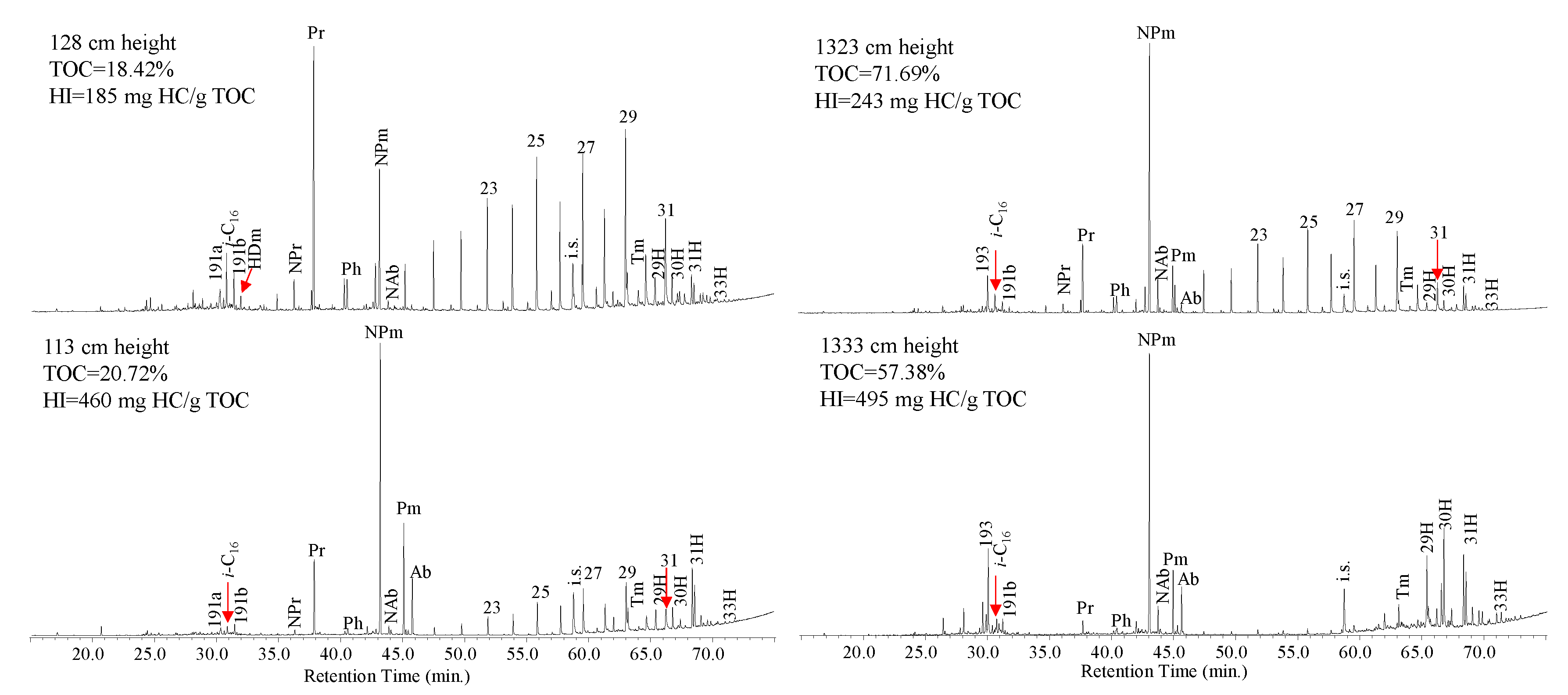
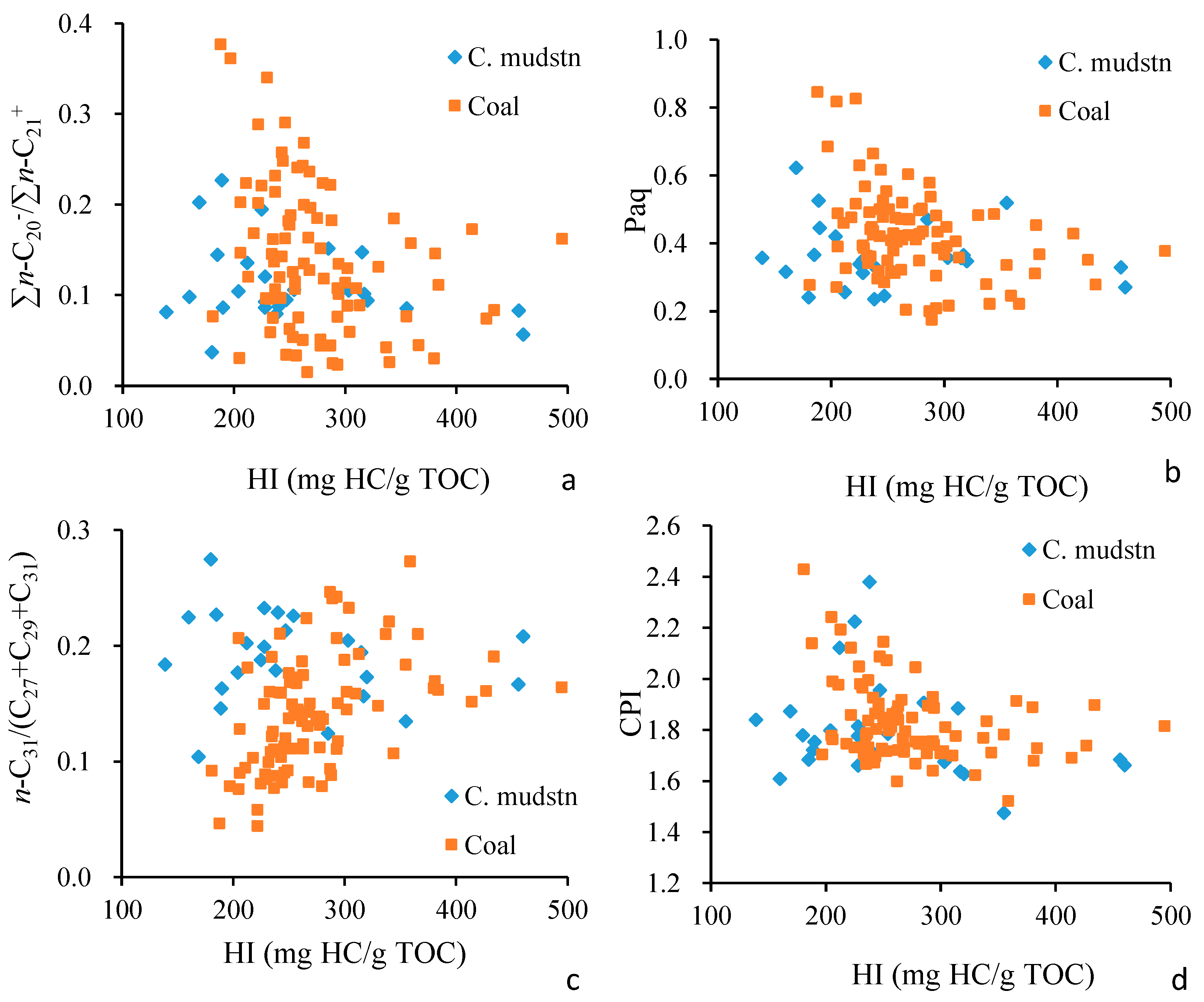
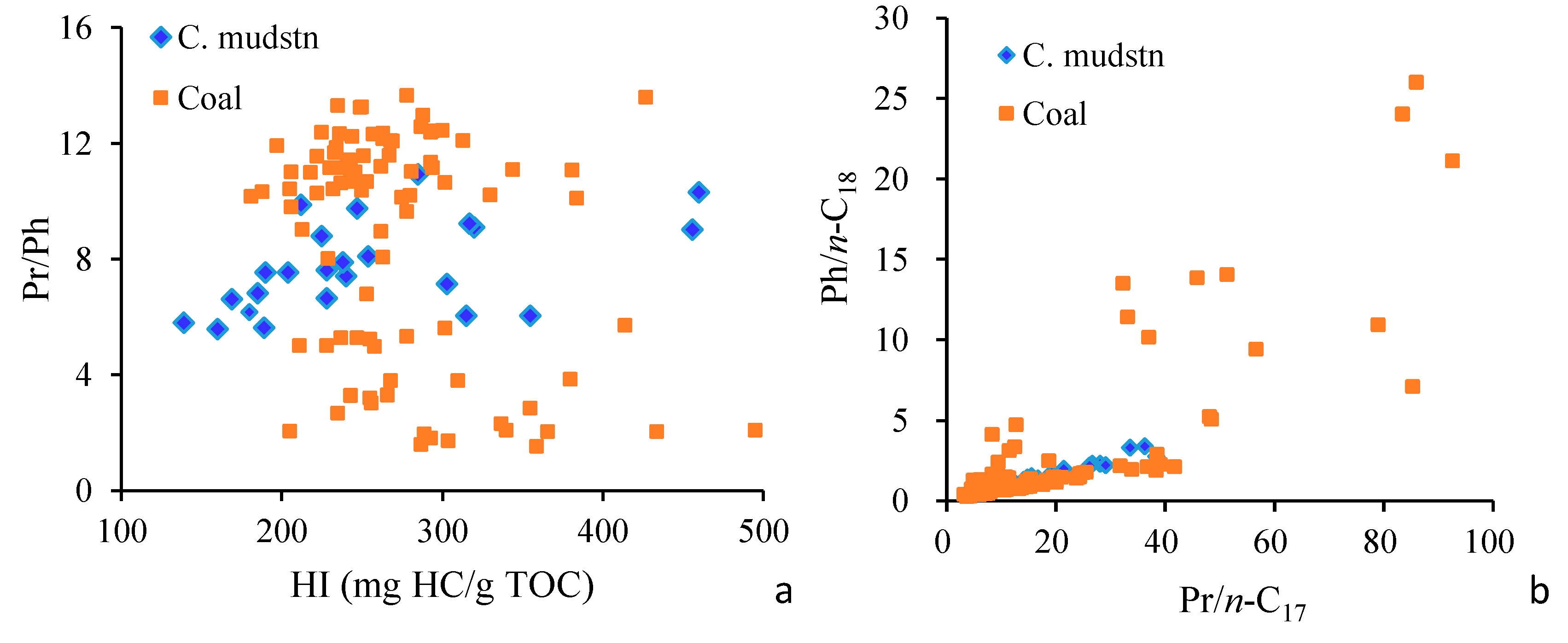
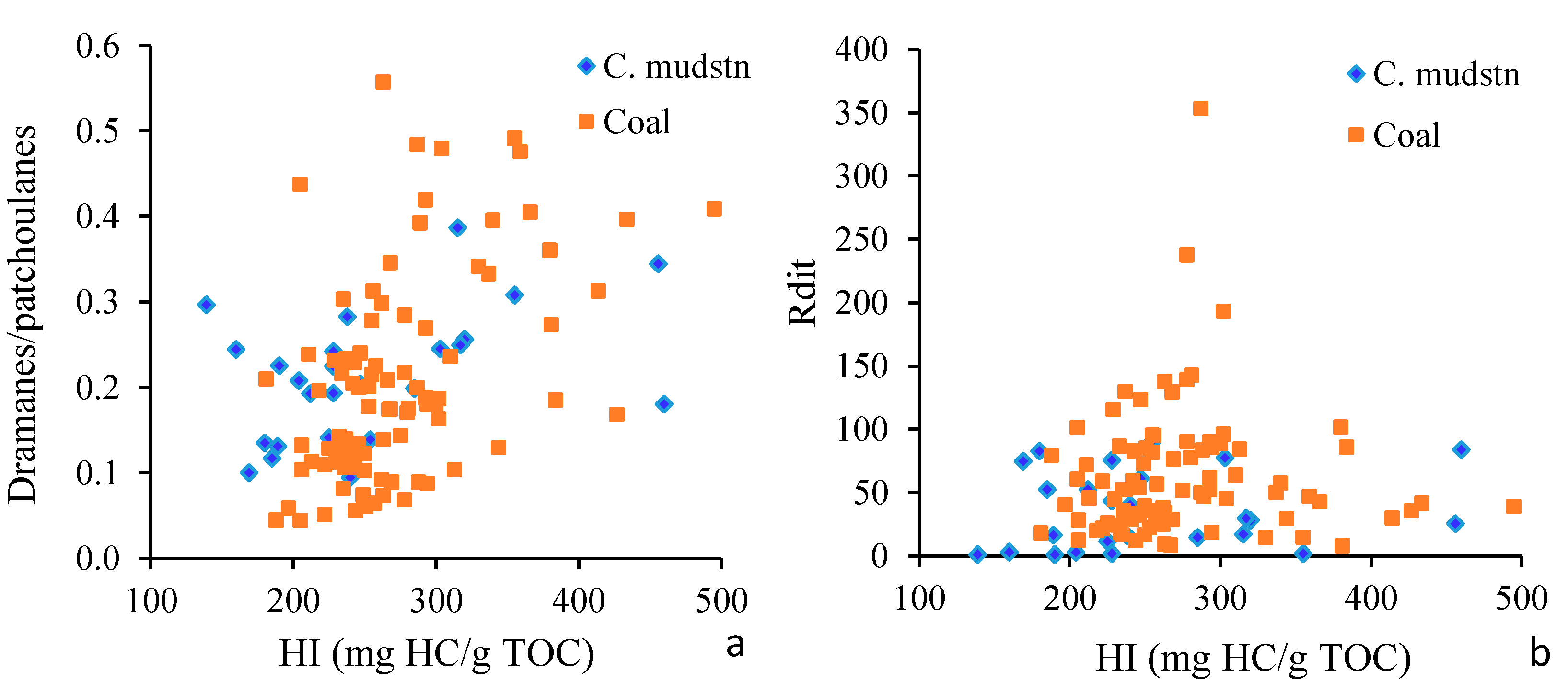
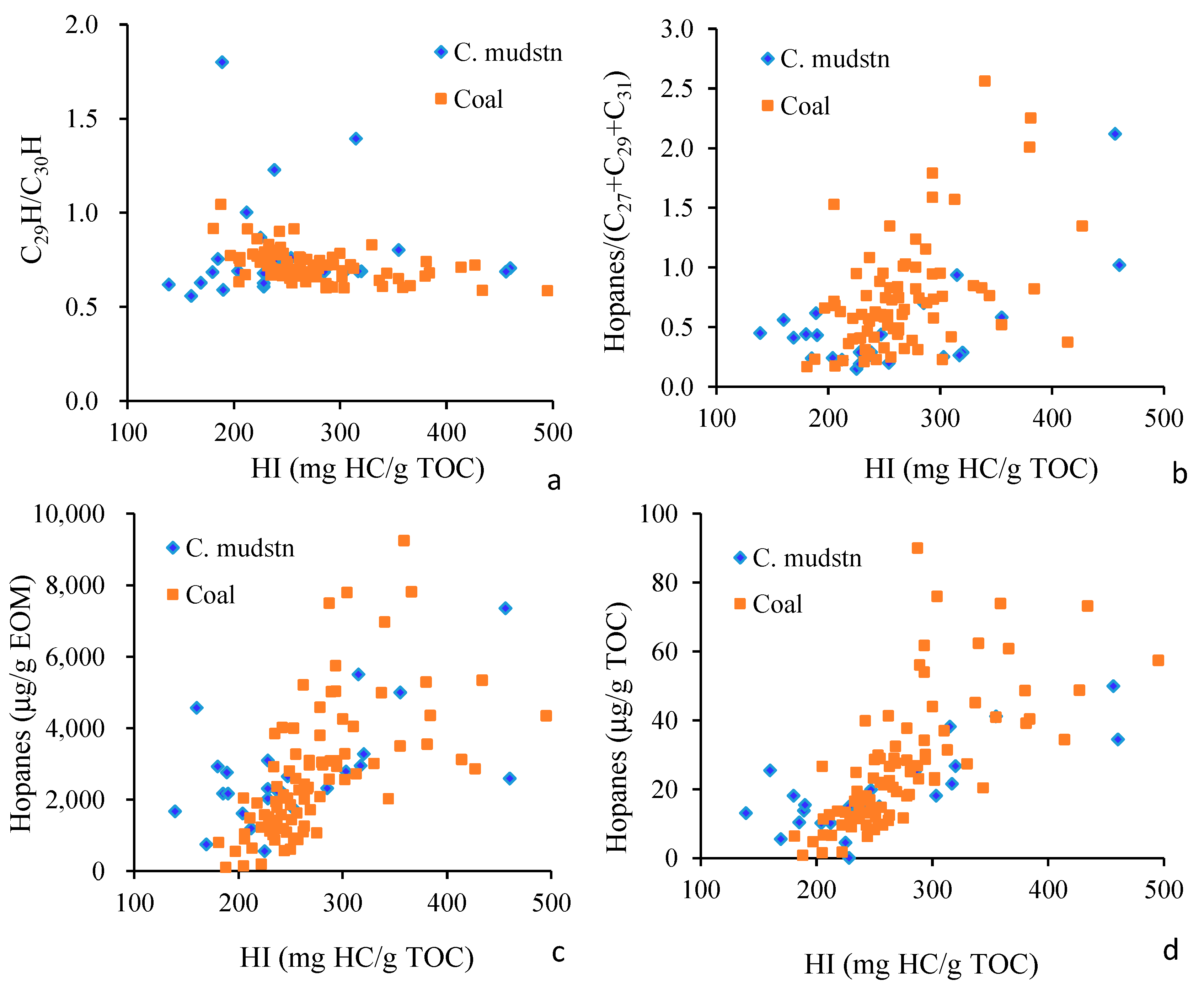
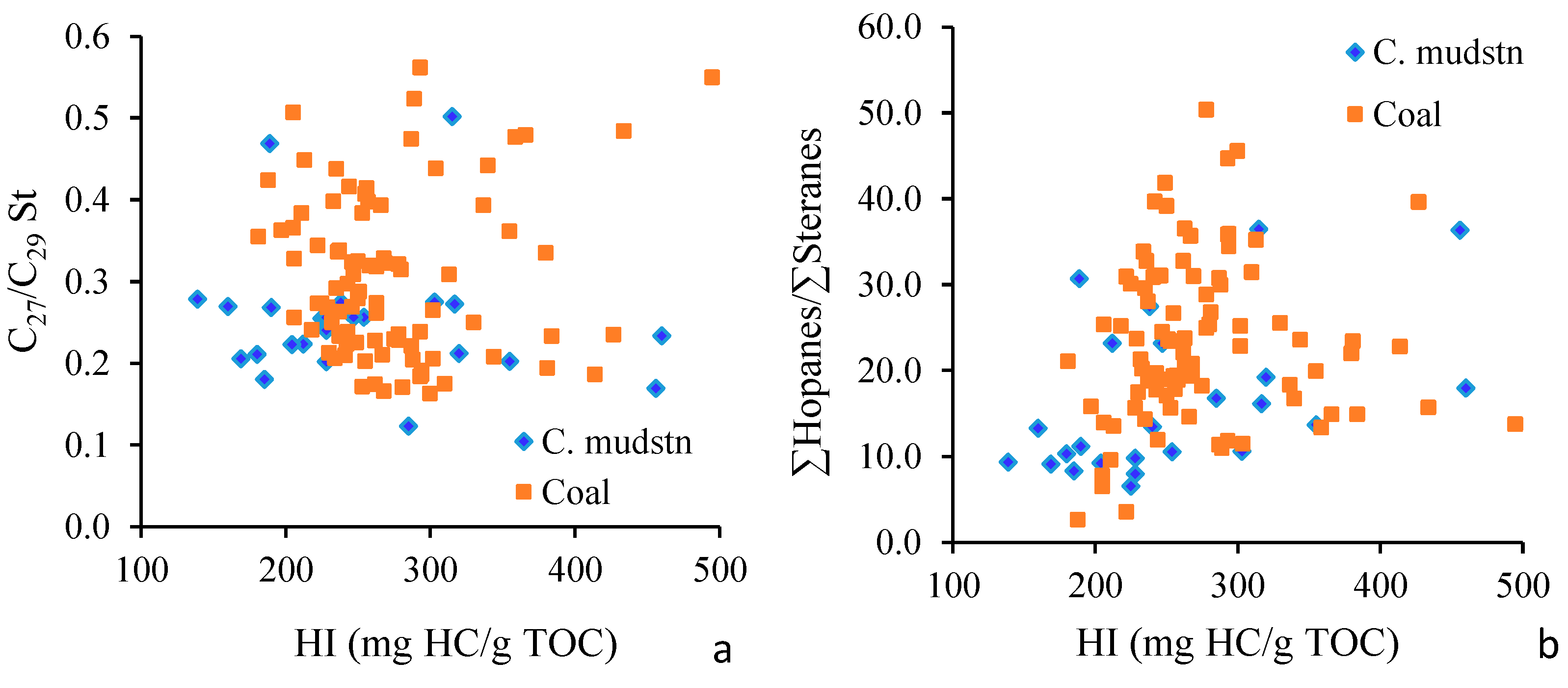

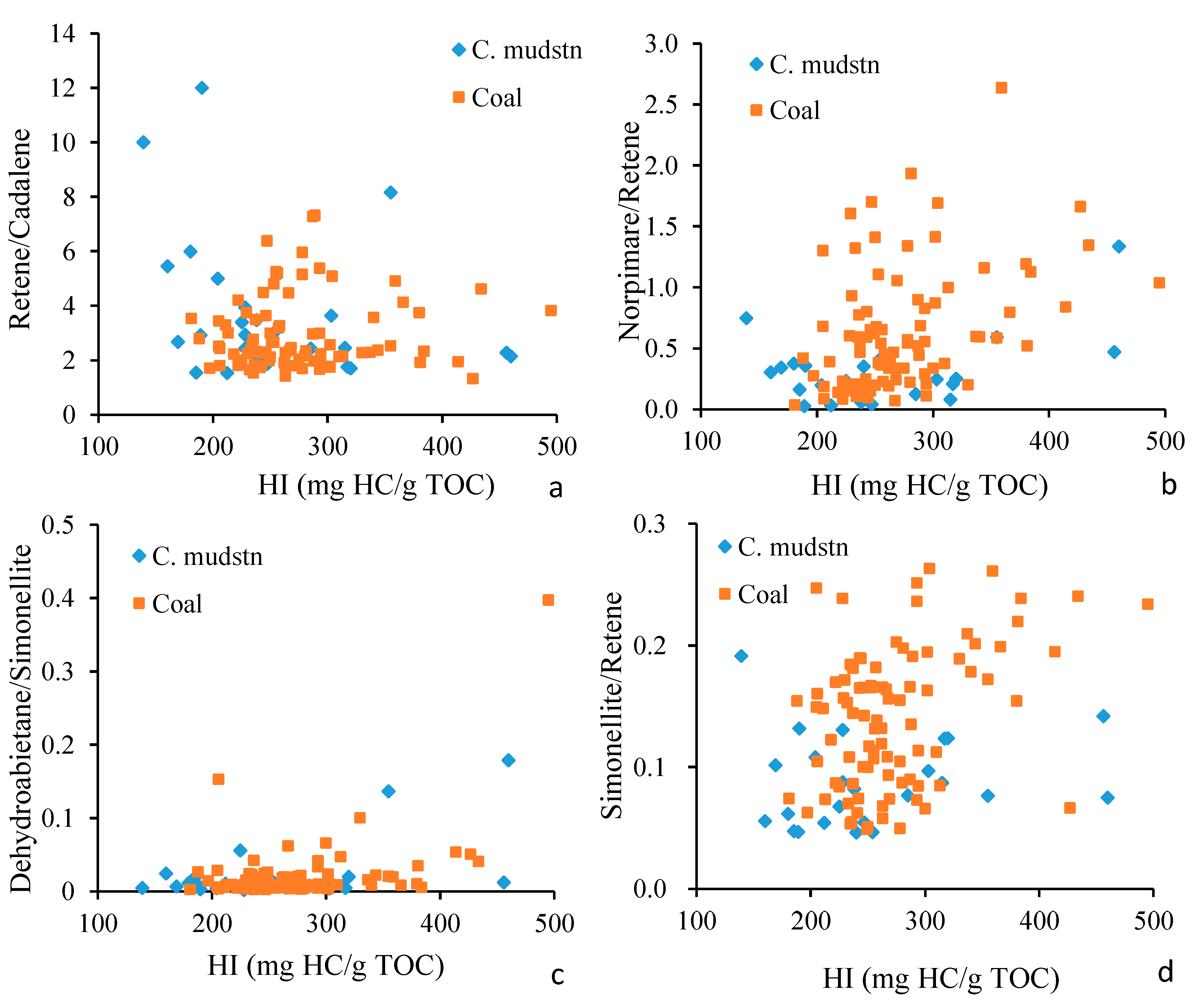
Disclaimer/Publisher’s Note: The statements, opinions and data contained in all publications are solely those of the individual author(s) and contributor(s) and not of MDPI and/or the editor(s). MDPI and/or the editor(s) disclaim responsibility for any injury to people or property resulting from any ideas, methods, instructions or products referred to in the content. |
© 2025 by the authors. Licensee MDPI, Basel, Switzerland. This article is an open access article distributed under the terms and conditions of the Creative Commons Attribution (CC BY) license (https://creativecommons.org/licenses/by/4.0/).
Share and Cite
Fu, Z.; Huang, H.; Xu, X.; Zhang, H.; Ma, Y. Hydrocarbon Generation Potential and Molecular Composition of Eocene Guchengzi Formation Coals and Carbonaceous Mudstones from the Fushun Basin, NE China. Energies 2025, 18, 519. https://doi.org/10.3390/en18030519
Fu Z, Huang H, Xu X, Zhang H, Ma Y. Hydrocarbon Generation Potential and Molecular Composition of Eocene Guchengzi Formation Coals and Carbonaceous Mudstones from the Fushun Basin, NE China. Energies. 2025; 18(3):519. https://doi.org/10.3390/en18030519
Chicago/Turabian StyleFu, Zhe, Haiping Huang, Xianghe Xu, Hong Zhang, and Yong Ma. 2025. "Hydrocarbon Generation Potential and Molecular Composition of Eocene Guchengzi Formation Coals and Carbonaceous Mudstones from the Fushun Basin, NE China" Energies 18, no. 3: 519. https://doi.org/10.3390/en18030519
APA StyleFu, Z., Huang, H., Xu, X., Zhang, H., & Ma, Y. (2025). Hydrocarbon Generation Potential and Molecular Composition of Eocene Guchengzi Formation Coals and Carbonaceous Mudstones from the Fushun Basin, NE China. Energies, 18(3), 519. https://doi.org/10.3390/en18030519






